jump start Mercury Monterey 2004 Owner's Manuals
[x] Cancel search | Manufacturer: MERCURY, Model Year: 2004, Model line: Monterey, Model: Mercury Monterey 2004Pages: 272, PDF Size: 4.29 MB
Page 2 of 272
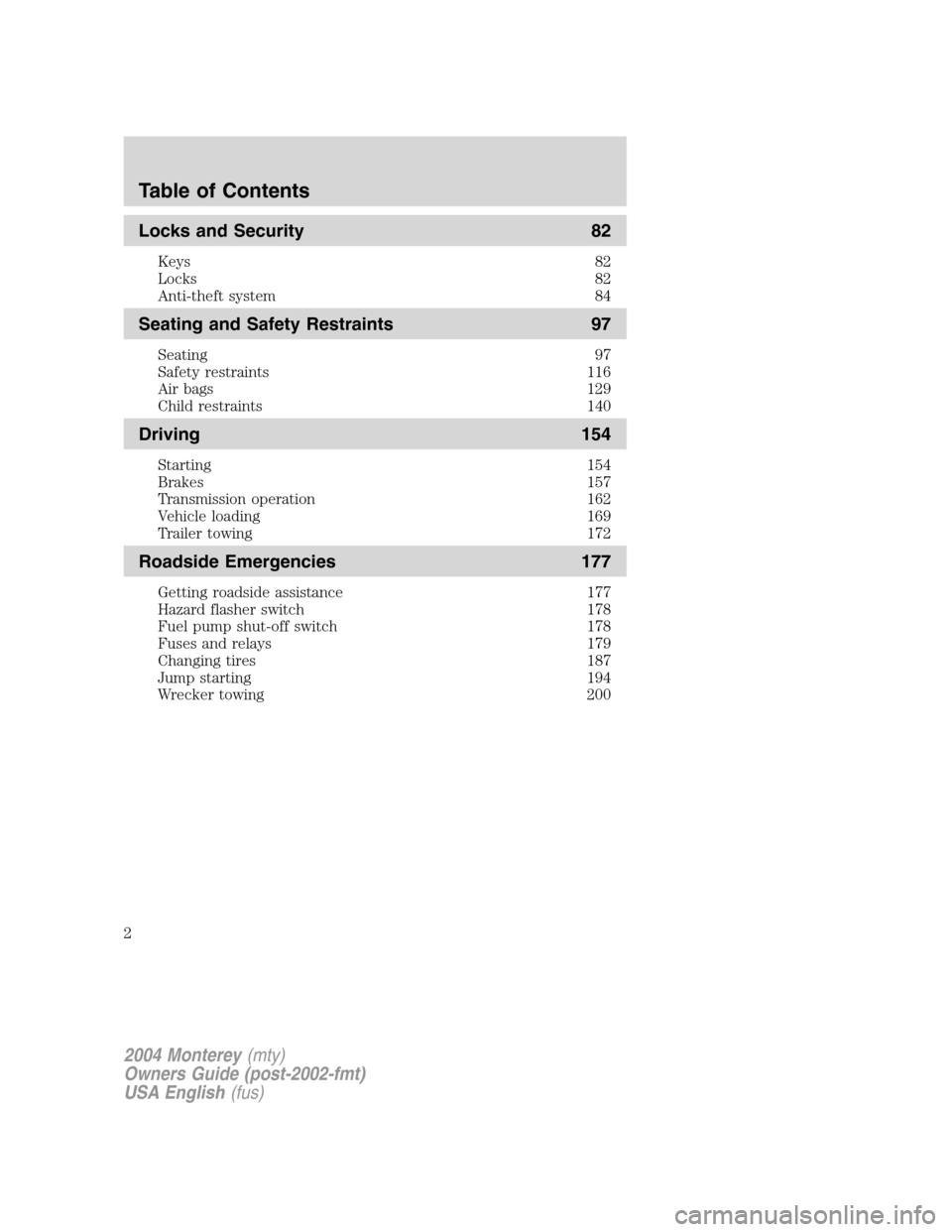
Locks and Security 82
Keys 82
Locks 82
Anti-theft system 84
Seating and Safety Restraints 97
Seating 97
Safety restraints 116
Air bags 129
Child restraints 140
Driving 154
Starting 154
Brakes 157
Transmission operation 162
Vehicle loading 169
Trailer towing 172
Roadside Emergencies 177
Getting roadside assistance 177
Hazard flasher switch 178
Fuel pump shut-off switch 178
Fuses and relays 179
Changing tires 187
Jump starting 194
Wrecker towing 200
2004 Monterey(mty)
Owners Guide (post-2002-fmt)
USA English(fus)
Table of Contents
2
Page 177 of 272

GETTING ROADSIDE ASSISTANCE
To fully assist you should you have a vehicle concern, Ford Motor
Company offers a complimentary roadside assistance program. This
program is separate from the New Vehicle Limited Warranty. The service
is available:
•24–hours, seven days a week
•for the New Vehicle Limited Warranty period of three years or 60,000
km (36,000 miles), whichever occurs first on Ford and Mercury
vehicles, and four years or 80,000 km (50,000 miles) on Lincoln
vehicles.
Roadside assistance will cover:
•changing a flat tire
•jump-starts
•lock-out assistance
•limited fuel delivery
•towing of your disabled vehicle to the nearest Ford Motor Company
dealership, or your selling dealer if within 56.3 km (35 miles) of the
nearest Ford Motor Company dealership (one tow per disablement).
Even non-warranty related tows, like accidents or getting stuck in the
mud or snow, are covered (some exclusions apply, such as impound
towing or repossession).
Canadian customers refer to your Owner Information Guide for
information on:
•coverage period
•exact fuel amounts
•towing of your disabled vehicle
•emergency travel expense reimbursement
•travel planning benefits
USING ROADSIDE ASSISTANCE
Complete the roadside assistance identification card and place it in your
wallet for quick reference. In the United States, this card is found in the
Owner Guide portfolio in the glove compartment in Ford vehicles and is
mailed to you if you own a Mercury or Lincoln. In Canada, the card is
found in the Owner Information Guide in the glove compartment.
U.S. Ford or Mercury vehicle customers who require roadside assistance,
call 1–800–241–3673; Lincoln vehicle customers call 1–800–521–4140.
2004 Monterey(mty)
Owners Guide (post-2002-fmt)
USA English(fus)
Roadside Emergencies
Roadside Emergencies
177
Page 194 of 272
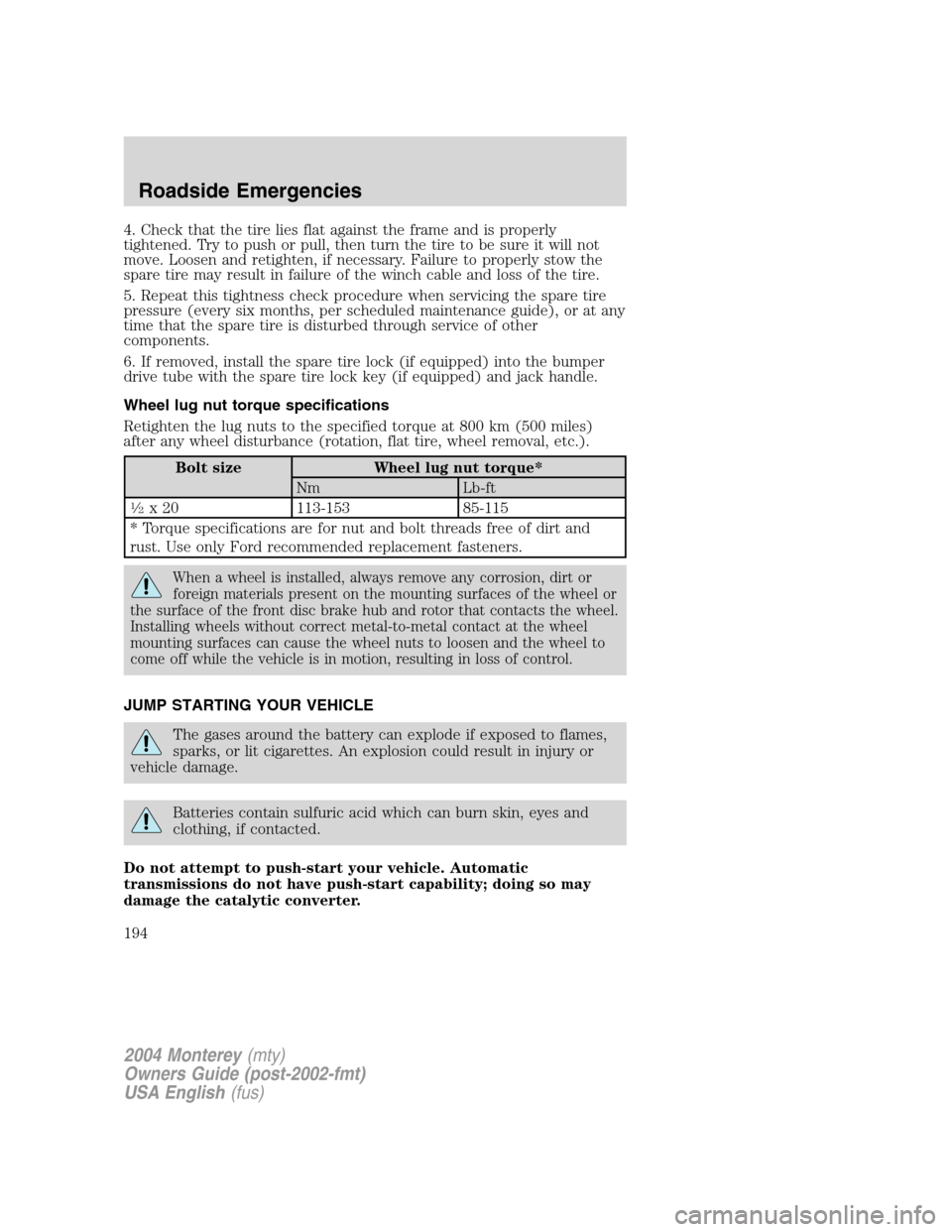
4. Check that the tire lies flat against the frame and is properly
tightened. Try to push or pull, then turn the tire to be sure it will not
move. Loosen and retighten, if necessary. Failure to properly stow the
spare tire may result in failure of the winch cable and loss of the tire.
5. Repeat this tightness check procedure when servicing the spare tire
pressure (every six months, per scheduled maintenance guide), or at any
time that the spare tire is disturbed through service of other
components.
6. If removed, install the spare tire lock (if equipped) into the bumper
drive tube with the spare tire lock key (if equipped) and jack handle.
Wheel lug nut torque specifications
Retighten the lug nuts to the specified torque at 800 km (500 miles)
after any wheel disturbance (rotation, flat tire, wheel removal, etc.).
Bolt size Wheel lug nut torque*
Nm Lb-ft
1⁄2x 20 113-153 85-115
* Torque specifications are for nut and bolt threads free of dirt and
rust. Use only Ford recommended replacement fasteners.
When a wheel is installed, always remove any corrosion, dirt or
foreign materials present on the mounting surfaces of the wheel or
the surface of the front disc brake hub and rotor that contacts the wheel.
Installing wheels without correct metal-to-metal contact at the wheel
mounting surfaces can cause the wheel nuts to loosen and the wheel to
come off while the vehicle is in motion, resulting in loss of control.
JUMP STARTING YOUR VEHICLE
The gases around the battery can explode if exposed to flames,
sparks, or lit cigarettes. An explosion could result in injury or
vehicle damage.
Batteries contain sulfuric acid which can burn skin, eyes and
clothing, if contacted.
Do not attempt to push-start your vehicle. Automatic
transmissions do not have push-start capability; doing so may
damage the catalytic converter.
2004 Monterey(mty)
Owners Guide (post-2002-fmt)
USA English(fus)
Roadside Emergencies
194
Page 195 of 272

Preparing your vehicle
When the battery is disconnected or a new battery is installed, the
transmission must relearn its shift strategy. As a result, the transmission
may have firm and/or soft shifts. This operation is considered normal and
will not affect function or durability of the transmission. Over time, the
adaptive learning process will fully update transmission operation.
1.Use only a 12–volt supply to start your vehicle.
2. Do not disconnect the battery of the disabled vehicle as this could
damage the vehicle’s electrical system.
3. Park the booster vehicle close to the hood of the disabled vehicle
making sure the two vehiclesdo nottouch. Set the parking brake on
both vehicles and stay clear of the engine cooling fan and other moving
parts.
4. Check all battery terminals and remove any excessive corrosion before
you attach the battery cables. Ensure that vent caps are tight and level.
5. Turn the heater fan on in both vehicles to protect any electrical
surges. Turn all other accessories off.
Connecting the jumper cables
1. Connect the positive (+) jumper cable to the positive (+) terminal of
the discharged battery.
Note:In the illustrations,lightning boltsare used to designate the
assisting (boosting) battery.
+–+–
2004 Monterey(mty)
Owners Guide (post-2002-fmt)
USA English(fus)
Roadside Emergencies
195
Page 197 of 272

4. Make the final connection of the negative (-) cable to an exposed
metal part of the stalled vehicle’s engine, away from the battery and the
carburetor/fuel injection system.Do notuse fuel lines, engine rocker
covers or the intake manifold asgroundingpoints.
Do not connect the end of the second cable to the negative (-)
terminal of the battery to be jumped. A spark may cause an
explosion of the gases that surround the battery.
5. Ensure that the cables are clear of fan blades, belts, moving parts of
both engines, or any fuel delivery system parts.
Jump starting
1. Start the engine of the booster vehicle and run the engine at
moderately increased speed.
2. Start the engine of the disabled vehicle.
3. Once the disabled vehicle has been started, run both engines for an
additional three minutes before disconnecting the jumper cables.
+–+–
2004 Monterey(mty)
Owners Guide (post-2002-fmt)
USA English(fus)
Roadside Emergencies
197
Page 199 of 272

3. Remove the jumper cable from the positive (+) terminal of the booster
vehicle’s battery.
4. Remove the jumper cable from the positive (+) terminal of the
disabled vehicle’s battery.
After the disabled vehicle has been started and the jumper cables
removed, allow it to idle for several minutes so the engine computer can
relearnits idle conditions.
+–+–
+–+–
2004 Monterey(mty)
Owners Guide (post-2002-fmt)
USA English(fus)
Roadside Emergencies
199
Page 266 of 272
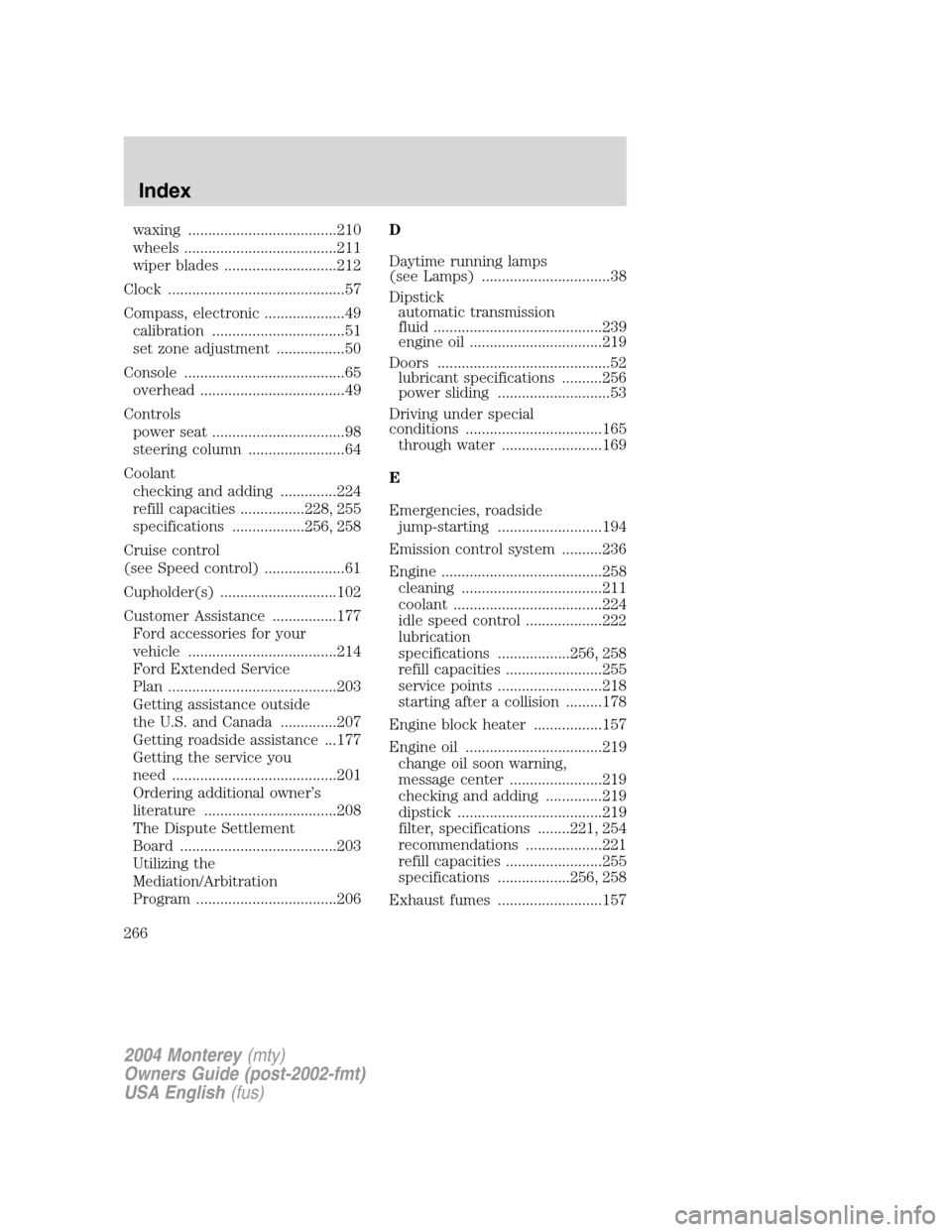
waxing .....................................210
wheels ......................................211
wiper blades ............................212
Clock ............................................57
Compass, electronic ....................49
calibration .................................51
set zone adjustment .................50
Console ........................................65
overhead ....................................49
Controls
power seat .................................98
steering column ........................64
Coolant
checking and adding ..............224
refill capacities ................228, 255
specifications ..................256, 258
Cruise control
(see Speed control) ....................61
Cupholder(s) .............................102
Customer Assistance ................177
Ford accessories for your
vehicle .....................................214
Ford Extended Service
Plan ..........................................203
Getting assistance outside
the U.S. and Canada ..............207
Getting roadside assistance ...177
Getting the service you
need .........................................201
Ordering additional owner’s
literature .................................208
The Dispute Settlement
Board .......................................203
Utilizing the
Mediation/Arbitration
Program ...................................206D
Daytime running lamps
(see Lamps) ................................38
Dipstick
automatic transmission
fluid ..........................................239
engine oil .................................219
Doors ...........................................52
lubricant specifications ..........256
power sliding ............................53
Driving under special
conditions ..................................165
through water .........................169
E
Emergencies, roadside
jump-starting ..........................194
Emission control system ..........236
Engine ........................................258
cleaning ...................................211
coolant .....................................224
idle speed control ...................222
lubrication
specifications ..................256, 258
refill capacities ........................255
service points ..........................218
starting after a collision .........178
Engine block heater .................157
Engine oil ..................................219
change oil soon warning,
message center .......................219
checking and adding ..............219
dipstick ....................................219
filter, specifications ........221, 254
recommendations ...................221
refill capacities ........................255
specifications ..................256, 258
Exhaust fumes ..........................157
2004 Monterey(mty)
Owners Guide (post-2002-fmt)
USA English(fus)
Index
266
Page 267 of 272
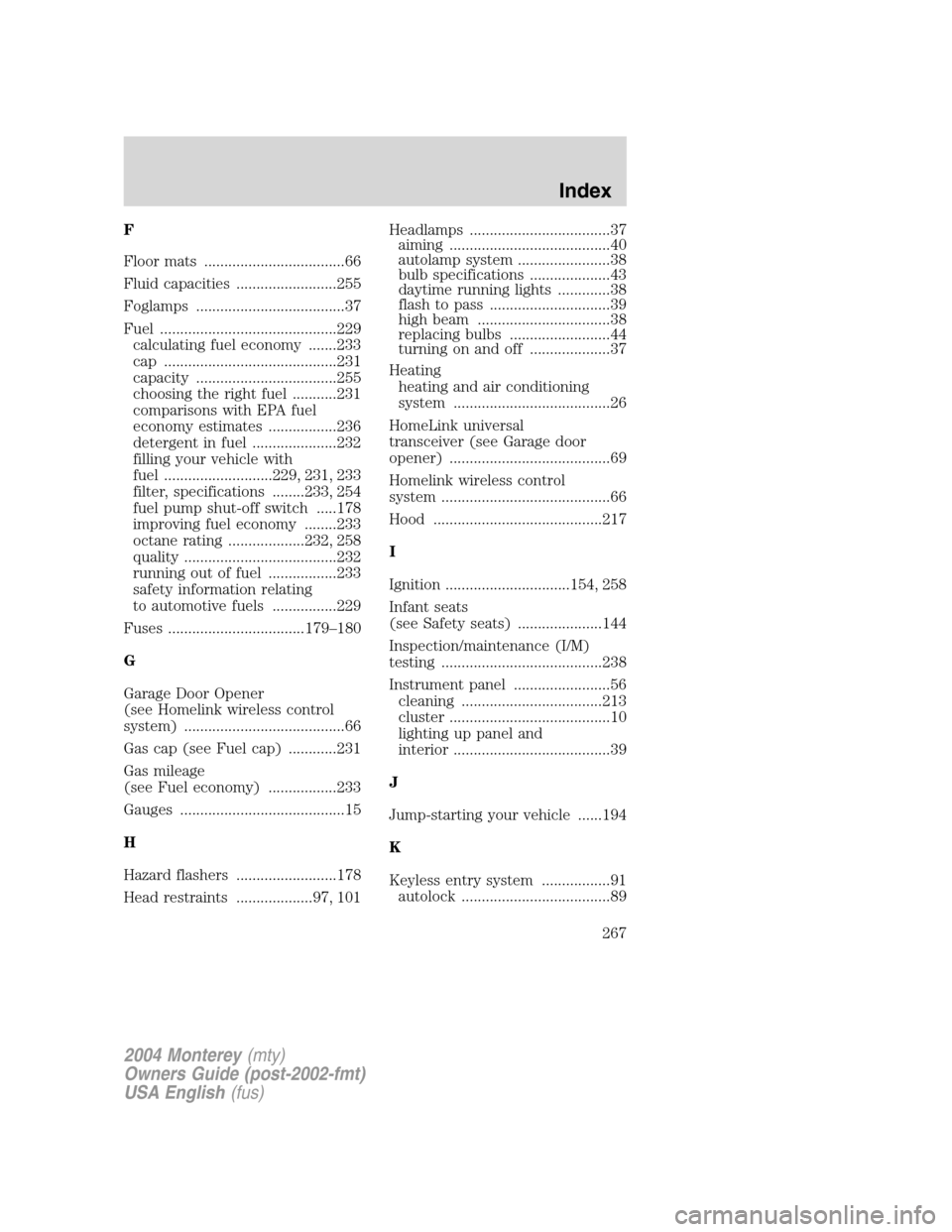
F
Floor mats ...................................66
Fluid capacities .........................255
Foglamps .....................................37
Fuel ............................................229
calculating fuel economy .......233
cap ...........................................231
capacity ...................................255
choosing the right fuel ...........231
comparisons with EPA fuel
economy estimates .................236
detergent in fuel .....................232
filling your vehicle with
fuel ...........................229, 231, 233
filter, specifications ........233, 254
fuel pump shut-off switch .....178
improving fuel economy ........233
octane rating ...................232, 258
quality ......................................232
running out of fuel .................233
safety information relating
to automotive fuels ................229
Fuses ..................................179–180
G
Garage Door Opener
(see Homelink wireless control
system) ........................................66
Gas cap (see Fuel cap) ............231
Gas mileage
(see Fuel economy) .................233
Gauges .........................................15
H
Hazard flashers .........................178
Head restraints ...................97, 101Headlamps ...................................37
aiming ........................................40
autolamp system .......................38
bulb specifications ....................43
daytime running lights .............38
flash to pass ..............................39
high beam .................................38
replacing bulbs .........................44
turning on and off ....................37
Heating
heating and air conditioning
system .......................................26
HomeLink universal
transceiver (see Garage door
opener) ........................................69
Homelink wireless control
system ..........................................66
Hood ..........................................217
I
Ignition ...............................154, 258
Infant seats
(see Safety seats) .....................144
Inspection/maintenance (I/M)
testing ........................................238
Instrument panel ........................56
cleaning ...................................213
cluster ........................................10
lighting up panel and
interior .......................................39
J
Jump-starting your vehicle ......194
K
Keyless entry system .................91
autolock .....................................89
2004 Monterey(mty)
Owners Guide (post-2002-fmt)
USA English(fus)
Index
267
Page 269 of 272
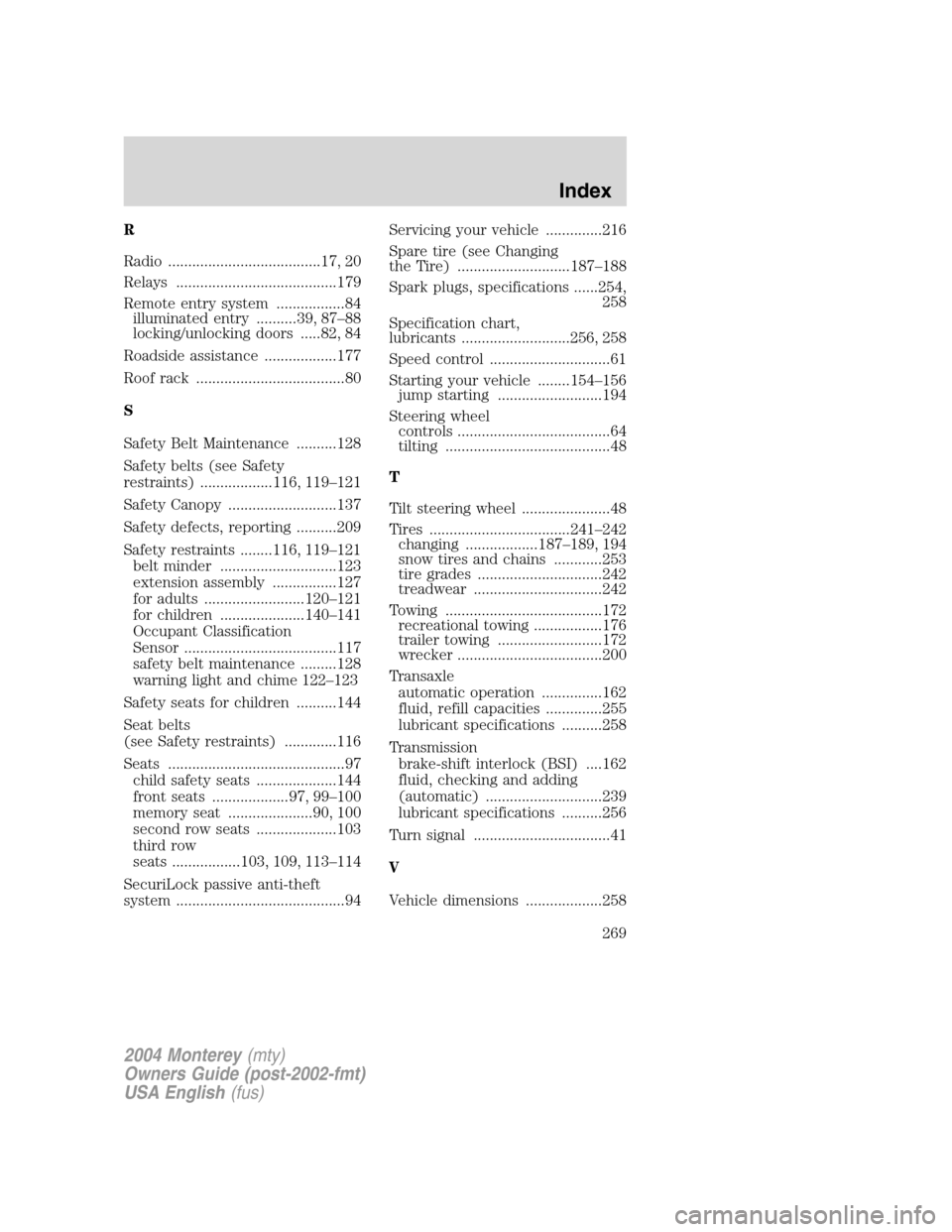
R
Radio ......................................17, 20
Relays ........................................179
Remote entry system .................84
illuminated entry ..........39, 87–88
locking/unlocking doors .....82, 84
Roadside assistance ..................177
Roof rack .....................................80
S
Safety Belt Maintenance ..........128
Safety belts (see Safety
restraints) ..................116, 119–121
Safety Canopy ...........................137
Safety defects, reporting ..........209
Safety restraints ........116, 119–121
belt minder .............................123
extension assembly ................127
for adults .........................120–121
for children .....................140–141
Occupant Classification
Sensor ......................................117
safety belt maintenance .........128
warning light and chime 122–123
Safety seats for children ..........144
Seat belts
(see Safety restraints) .............116
Seats ............................................97
child safety seats ....................144
front seats ...................97, 99–100
memory seat .....................90, 100
second row seats ....................103
third row
seats .................103, 109, 113–114
SecuriLock passive anti-theft
system ..........................................94Servicing your vehicle ..............216
Spare tire (see Changing
the Tire) ............................187–188
Spark plugs, specifications ......254,
258
Specification chart,
lubricants ...........................256, 258
Speed control ..............................61
Starting your vehicle ........154–156
jump starting ..........................194
Steering wheel
controls ......................................64
tilting .........................................48
T
Tilt steering wheel ......................48
Tires ...................................241–242
changing ..................187–189, 194
snow tires and chains ............253
tire grades ...............................242
treadwear ................................242
Towing .......................................172
recreational towing .................176
trailer towing ..........................172
wrecker ....................................200
Transaxle
automatic operation ...............162
fluid, refill capacities ..............255
lubricant specifications ..........258
Transmission
brake-shift interlock (BSI) ....162
fluid, checking and adding
(automatic) .............................239
lubricant specifications ..........256
Turn signal ..................................41
V
Vehicle dimensions ...................258
2004 Monterey(mty)
Owners Guide (post-2002-fmt)
USA English(fus)
Index
269